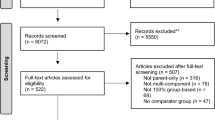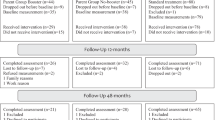Abstract
Background/Objectives:
To determine if a multi-component family focused education package is more effective than a waiting list control group in treating overweight and obese children.
Subjects/Methods:
A 2-year randomised controlled trial; 65 overweight and obese children aged 6–14 years were allocated to active intervention in either the first or second year, with body composition monitoring alone in the control period. Anthropometric measurements were undertaken at six monthly intervals and a 7-day food and activity diary were issued.
Results:
Over the 2 years of the study body mass index (BMI) SDS (z score) fell significantly in the intervention/control (I/C) group, but not in the control/intervention (C/I) group. The difference between groups was 0.3, which was borderline significant (95% confidence interval (95% CI) −0.62 to 0.02, P=0.06) before adjusting for potential confounding factors. Thirty-three percent of the I/C group and 12% of the C/I group achieved the target reduction of 0.5 BMI SDS. The I/C group had a significantly greater reduction in the percentage with a BMI above the 99.6th centile at 24 months (P=0.04) and gained 5.7 kg less over the time of the study. There were no significant differences between groups for mean percentage attendance at physical activity sessions (I/C group=24.1%, 95% CI, 15.4–32.9; C/I group=31.7%, 95% CI, 22.4–41.1, P=0.229).
Conclusions:
Children given active intervention followed by body composition monitoring alone reduced their BMI SDS, and fewer children were classified as grossly overweight by the end of the study. If these findings are true, there are important implications for the provision of services managing overweight in the community.
This is a preview of subscription content, access via your institution
Access options
Subscribe to this journal
Receive 12 print issues and online access
$259.00 per year
only $21.58 per issue
Buy this article
- Purchase on Springer Link
- Instant access to full article PDF
Prices may be subject to local taxes which are calculated during checkout

Similar content being viewed by others
References
Bravata DM, Smith-Spangler CS, Sundaram V, Gienger AL, Lin N, Lewis R (2007). Using pedometers to increase physical activity and improve health. JAMA 298, 2296–2304.
Cole TJ, Freeman JV, Preece MA (1995). Body mass index reference curves for the UK, 1990. Arch Dis Child 73, 25–29.
Ford AL, Hunt LP, Cooper A, Shield JPH (2010). What reduction in BMI SDS is required in obese adolescents to improve body composition and cardiometabolic health? Arch Dis Child 95, 256–261.
Hughes AR, Stewart L, Chapple J, McColl JH, Donaldson MDC, Kelnar CJH et al. (2008). Randomised, controlled trial of a best-practice individualized behavioural program for treatment of childhood overweight: Scottish Childhood Overweight Treatment Trial (SCOTT). Pediatrics 121, 539–546.
Hunt LP, Ford A, Sabin MA, Crowne EC, Shield JPH (2007). Clinical measures of adiposity and percentage fat loss: which measure most accurately reflects fat loss and what should we aim for? Arch Dis Child 92, 399–403.
Livingstone MBE, Robson PJ (2000). Measure of dietary intake in children. Proc Nutr Soc 59, 279–293.
Lohman TG, Roche AF, Martorell R (1991). Anthropometric Standardization Reference Manual. Human Kinetic Books.
Margetts BM, Nelson M (1997). Design Concepts in Nutritional Epidemiology, 2nd edn. Oxford University Press: Oxford.
Health Improvement Strategy for Jersey (2008–2018). New Directions, Health for Life, 2008.
National Institute for Health and Clinical Excellence (2006). Obesity-Guidance on the Prevention, Identification, Assessment and Management of Overweight and Obesity in Adults and Children NICE clinical guideline 43, December 2006.
Oude Luttikhuis H, Baur L, Jansen H, Shrewsbury VA, O’Malley C, Stolk RP et al. (2009). Interventions for treating obesity in children (Review). The Cochrane Collaboration.
Pott W, Albayrak O, Hebebrand J, Pauli-Pott U (2009). Treating childhood obesity: family background variables and the child's success in a weight-control intervention. Int J Eat Disord 42, 284–289.
Reinehr T, Andler W (2004). Changes in the atherogenic risk factor profile according to degree of weight loss. Arch Dis Child 89, 419–422.
Reinehr T, Kleber M, Lass N, Toschke AM (2010). Body mass index patterns over 5 y in obese children motivated to participate in a 1-y lifestyle intervention: age as a predictor of long-term success. Am J Clin Nutr 91, 1165–1171.
Rennie KL, Wells JCK, McCaffrey A, Livingstone MB (2006). The effect of physical activity on body fatness in children and adolescents. Proc Nutr Soc 65, 393–402.
Rudolf M, Christie D, McElhone S, Sahota P, Dixey R, Walker J et al. (2006). WATCH IT: a community based programme for obese children and adolescents. Arch Dis Child 91, 736–739.
Sabin MA, Ford A, Hunt L, Jamal R, Crowne EC, Shield JPH (2007). Which factors are associated with a successful outcome in a weight management programme for obese children. J Eval Clin Pract 13, 364–368.
Sacher PM, Kolotourou M, Chadwick P, Singhal A, Cole TJ, Lawson MS (2007a). The MEND Programme: effects on waist circumference and BMI in moderately obese children. Obes Rev 8, 7–16:12.
Sacher PM, Chadwick P, Kolotourou M, Cole TJ, Lawson M, Singhal A (2007b). The MEND RCT: effectiveness on health outcomes in obese children. Int J Obes 31, S1.
Sacher PM, Chadwick P, Kolotourou M, Cole TJ, Lawson MS, Singhal A (2007c). The MEND Trial: sustained improvements on health outcomes in obese children at one year. Obesity 15, A92.
Scottish Intercollegiate Guidelines Network (2010). Management of Obesity: A National Clinical guideline. Edinburgh: SIGN.
The Information Centre (2008). National Child Measurement Programme 2006/2007 School Year, Headline Results.
Acknowledgements
We would like to thank Wessex Medical Research and The Public Health Department in States of Jersey for funding this project and all the families who have taken part. We would also like to thank Andrew Heaven, Jenny O’Brien, Lynn Minchinton-Gilley, Daphne Glaun, Anna Skinner, Marcia Smith, Sharon Dundon, Eugene Ellis, Dave De Abreu, Craig Gascoyne, Stuart Gilmour, Jodie Botterill, Michele Horwood, Dave Black and Simon Alberici for all their hard work. We would also like to thank the Department of Education, Sports and Culture, States of Jersey for funding all the activities; Channel Islands Coop for funding food for all the healthy eating workshops; and Jersey Bowl for sponsoring the Family Project Xmas party.
Author information
Authors and Affiliations
Corresponding author
Ethics declarations
Competing interests
The authors declare no conflict of interest.
Rights and permissions
About this article
Cite this article
Coppins, D., Margetts, B., Fa, J. et al. Effectiveness of a multi-disciplinary family-based programme for treating childhood obesity (The Family Project). Eur J Clin Nutr 65, 903–909 (2011). https://doi.org/10.1038/ejcn.2011.43
Received:
Revised:
Accepted:
Published:
Issue Date:
DOI: https://doi.org/10.1038/ejcn.2011.43
Keywords
This article is cited by
-
Longitudinal, cross-cohort comparison of physical activity patterns in Chinese mothers and children
International Journal of Behavioral Nutrition and Physical Activity (2012)



